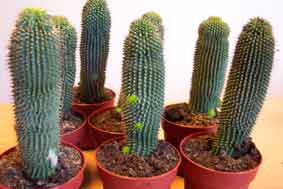Celebrating the fruits of San traditional knowledge: The Hoodia Gordonii plant
Speech delivered by
KXAO MOSES ‡OMA
Chairperson of the Board of Trustees of the
Working Group of Indigenous Minorities in Southern Africa (WIMSA)
to the
SAN HOODIA BENEFIT SHARING AGREEMENT CELEBRATION
at Molopo Lodge, South Africa, on 24 March 2003
As hunter-gatherers the San have survived directly from the land for centuries already. In the past,
however, we had control over land and natural resources, so our ancestors had what they needed to
survive despite a dry climate and any other difficult conditions they might have faced. They learnt to
be attentive to what was happening with the weather, the land and the animals; they became keenly
aware of rainfall patterns, game movements and veld-food availability. These skills enabled us to
survive.
When other groups in the region also became aware of the land's richness in resources, they occupied
much of the richest land. Our ancestors were dispossessed of their land. Not being regarded as equals
of the new `landowners', they were killed, forced into slavery on their own land or otherwise driven
into marginal areas. Though nearly all San groups around the region lost their land base and some
almost lost their language too, the elderly San continued passing on to the younger generations the
traditional knowledge of fauna and flora.
The Hoodia is a good example of a plant that all generations of San have learnt about from their
forebears. We San of Angola, Namibia, Botswana and South Africa know that Hoodia sap can be
used to treat eye infections; that the brew of boiled Hoodia pieces can be used to treat severe stomach
pain; and of course, that Hoodia suppresses hunger and helps to maintain a high energy level. Indeed
Hoodia is one of the important traditional medicinal plants that San have collected and utilised for
centuries past.

We are delighted that a part of our traditional knowledge is being honoured on this historic occasion.
For us it is an occasion to celebrate. It is of critical importance to us that the Council for Scientific and
Industrial Research (CSIR) has acknowledged our traditional knowledge of the Hoodia as the source
of information that started the process leading to the granting of the patent in 1995.
From the start the WIMSA General Assembly has closely observed the South African San Council
and CSIR negotiations around the Hoodia. I am happy to say that the South African San Council took
its mandate seriously and deserves praise for a job well done. My dear fellow San, I wish to thank you
for your hard work, in which you were supported by our remarkable lawyer, Roger Chennells, to
whom I also extend a hearty thanks. After the first round of negotiations we rejoiced in the signing
of a memorandum of understanding between the San and the CSIR. Today we rejoice in the signing
of a benefit-sharing agreement as the outcome of the second round.
The San culture - including our traditional knowledge - has been put to use by external parties for
multiple purposes, with little or no benefit accruing to the San. Recently the CSIR and several media
workers and academics have set a positive example by signing agreements with the San and thus not
exploiting us as has been the norm. The international interest that the agreement between the San and
the CSIR has aroused has helped the San umbrella body, WIMSA, to raise awareness of the need to
protect and control San intellectual property. We hope that commercial concerns will soon follow the
CSIR example and stop using images of San in their adverts without our prior consent and without
ensuring that we also benefit, financially or otherwise.
It must be noted that all benefits accruing to us from our sharing of our intellectual property are put to
use by WIMSA through its many San member organisations in implementing sound and sustainable
development projects, in providing skills training and education to San, and in building institutional
capacity among San groups across the region.
Again I thank the members of the South African San Council and our lawyer Roger Chennells, as
well as the CSIR representatives and the organisers of this splendid celebration for their respective
contributions. May we all enjoy the day in harmony and peace!